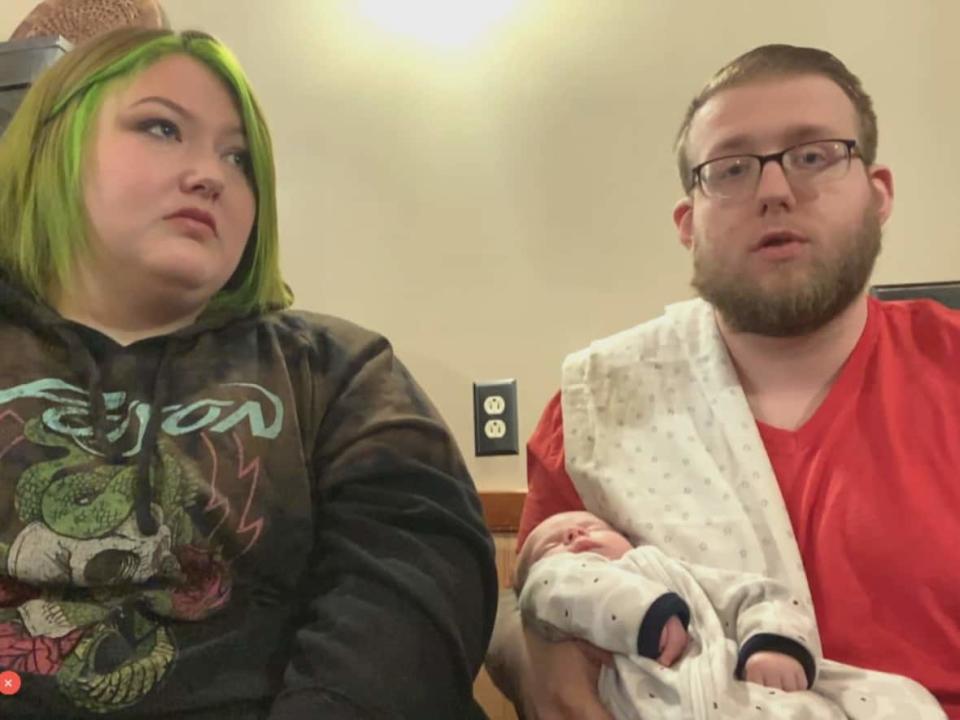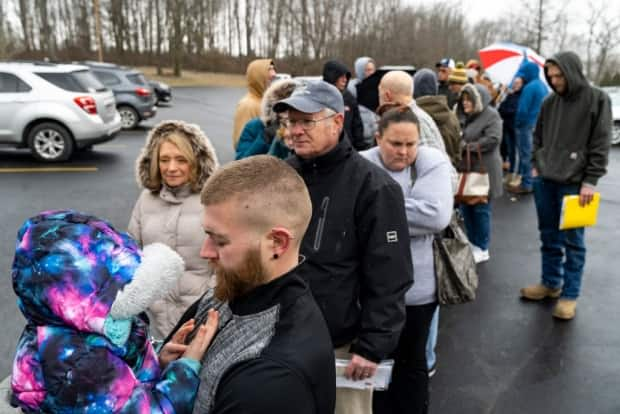Mom who fled with baby after toxic derailment wants officials to 'drink the water' in Ohio town

A couple with an infant son who fled their home after a toxic train derailment in Ohio earlier this month are not convinced it's safe to return home, despite what state officials have said.
The Feb. 3 derailment prompted officials to evacuate hundreds of people from their homes in the town of East Palestine amid fears that a hazardous, highly flammable material might ignite.
To prevent toxic vinyl chloride gas — used in the production of PVC plastic — from exploding, officials carried out a controlled release of the fumes. The gas was vented and burned after being diverted to a trench, sending a plume of smoke over the town for days.
East Palestine residents Kasie and Nathaniel Locke remember the night of the derailment, with Kasie telling CBC News they've been "stuck in limbo" ever since, staying with her mother in North Lima, about a 16-minute drive from the site.
WATCH | Ohio family describes disruption, health impacts of toxic spill:
Dozens of cars of the Pennsylvania-bound freight train derailed shortly before 9 p.m. on a Friday, and the young family left home around 2 a.m. the next day.
It smelled like "really intense" burning rubber and oil and they "couldn't breathe," said Nathaniel.
"We both had to wrap our faces in receiving blankets from Lucas."
They said they experienced headaches, runny noses, and burning and numb eyes and throats.
Kasie said it's been "anxiety-inducing" thinking about the health of her child.
"It's very scary. I mean, we don't feel safe going back ... not with a two-month-old," she said. "Consciously, I can't do it. I don't know what effects it will have on his health."
She said baby Lucas has since been taken to Akron Children's Hospital to get his nose suctioned out, and they've used saline and a nasal aspirator to manage his congestion, adding that she's not sure if he's sick or if the symptoms are related to the derailment.
Evacuation orders were lifted Feb. 8, when Ohio Gov. Mike DeWine and other officials said it was safe for the residents of the community to return home.
State testing of municipal drinking water
DeWine on Friday said a plume of pollution that had been moving down the Ohio River had dissipated, and said state testing never showed that any contaminated water entered any municipal drinking systems in its path.
In response to the derailment and safety concerns it raises, U.S. Senate commerce committee chair Maria Cantwell late on Friday said she has opened an inquiry into railroad hazardous materials safety practices.

The head of the U.S. Environmental Protection Agency got a first-hand look Thursday at the toll left by the derailment.
EPA Administrator Michael Regan said Thursday that anyone who is fearful of being in their home should seek testing from the government.
"People have been unnerved. They've been asked to leave their homes," he said, adding that if he lived there, he would be willing to move his family back into the area as long as the testing shows it's safe.
The Ohio EPA said the latest tests show five wells supplying the town's drinking water are free from contaminants.

U.S. Transportation Secretary Pete Buttigieg said Sunday he will call on major railroads to improve safety in light of the derailment.
Writing to railroad executive Alan Shaw — whose company, Norfolk Southern, operated the derailed train — Buttigieg added that he would call on Congress to raise the cap on fines against railroads for violating safety regulations.
Norfolk Southern said Sunday that it "received a copy of the letter from the secretary and are reviewing." Shaw said last week the railroad had established an initial $1 million US community support fund and distributed $1.7 million US in direct financial assistance to more than 1,100 families and businesses to cover evacuation costs.
"We will not let you down," he told residents in a letter.
'Would they bring their family back?'
Kasie Locke has a challenge for officials who believe the town of 4,700 is a safe place to live.
"I would like them to come stay in East Palestine and drink the water, shower with the water. I'd like to hear them tell us, would they like to live here? Would they bring their children here? Would they bring their family back? Because it would be hard for me to believe they would say yes."

The U.S. Health and Human Services Department and the Centers for Disease Control and Prevention (CDC) said Friday they were deploying a team of medical personnel and toxicologists to conduct public health testing and assessments.
Federal Railroad Administration chief Amit Bose will visit the site next week and the Environmental Protection Agency is stepping up testing.

